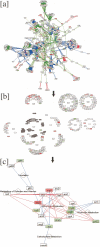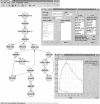Cytoscape: a software environment for integrated models of biomolecular interaction networks
- PMID: 14597658
- PMCID: PMC403769
- DOI: 10.1101/gr.1239303
Cytoscape: a software environment for integrated models of biomolecular interaction networks
Abstract
Cytoscape is an open source software project for integrating biomolecular interaction networks with high-throughput expression data and other molecular states into a unified conceptual framework. Although applicable to any system of molecular components and interactions, Cytoscape is most powerful when used in conjunction with large databases of protein-protein, protein-DNA, and genetic interactions that are increasingly available for humans and model organisms. Cytoscape's software Core provides basic functionality to layout and query the network; to visually integrate the network with expression profiles, phenotypes, and other molecular states; and to link the network to databases of functional annotations. The Core is extensible through a straightforward plug-in architecture, allowing rapid development of additional computational analyses and features. Several case studies of Cytoscape plug-ins are surveyed, including a search for interaction pathways correlating with changes in gene expression, a study of protein complexes involved in cellular recovery to DNA damage, inference of a combined physical/functional interaction network for Halobacterium, and an interface to detailed stochastic/kinetic gene regulatory models.
Figures





Similar articles
-
Cytoscape: a community-based framework for network modeling.Methods Mol Biol. 2009;563:219-39. doi: 10.1007/978-1-60761-175-2_12. Methods Mol Biol. 2009. PMID: 19597788
-
Visualization of protein interaction networks: problems and solutions.BMC Bioinformatics. 2013;14 Suppl 1(Suppl 1):S1. doi: 10.1186/1471-2105-14-S1-S1. Epub 2013 Jan 14. BMC Bioinformatics. 2013. PMID: 23368786 Free PMC article.
-
Cytoscape StringApp: Network Analysis and Visualization of Proteomics Data.J Proteome Res. 2019 Feb 1;18(2):623-632. doi: 10.1021/acs.jproteome.8b00702. Epub 2018 Dec 5. J Proteome Res. 2019. PMID: 30450911 Free PMC article.
-
Biological Network Inference and analysis using SEBINI and CABIN.Methods Mol Biol. 2009;541:551-76. doi: 10.1007/978-1-59745-243-4_24. Methods Mol Biol. 2009. PMID: 19381531 Review.
-
Discerning molecular interactions: A comprehensive review on biomolecular interaction databases and network analysis tools.Gene. 2018 Feb 5;642:84-94. doi: 10.1016/j.gene.2017.11.028. Epub 2017 Nov 10. Gene. 2018. PMID: 29129810 Review.
Cited by
-
Decoding neuronal genes in stroke-induced pain: insights from single-nucleus sequencing in mice.BMC Neurol. 2024 Nov 25;24(1):459. doi: 10.1186/s12883-024-03965-w. BMC Neurol. 2024. PMID: 39581982 Free PMC article.
-
IFNγ-secreting T cells that highly express IL-2 potently inhibit the growth of intracellular M. tuberculosis in macrophages.Front Immunol. 2024 Nov 7;15:1469118. doi: 10.3389/fimmu.2024.1469118. eCollection 2024. Front Immunol. 2024. PMID: 39575242 Free PMC article.
-
A machine learning model revealed that exosome small RNAs may participate in the development of breast cancer through the chemokine signaling pathway.BMC Cancer. 2024 Nov 21;24(1):1435. doi: 10.1186/s12885-024-13173-x. BMC Cancer. 2024. PMID: 39574053 Free PMC article.
-
Multi-layered proteomics identifies insulin-induced upregulation of the EphA2 receptor via the ERK pathway which is dependent on low IGF1R level.Sci Rep. 2024 Nov 21;14(1):28856. doi: 10.1038/s41598-024-77817-5. Sci Rep. 2024. PMID: 39572596 Free PMC article.
-
Expanding the genome information on Bacillales for biosynthetic gene cluster discovery.Sci Data. 2024 Nov 21;11(1):1267. doi: 10.1038/s41597-024-04118-x. Sci Data. 2024. PMID: 39572589 Free PMC article.
References
-
- Batagelj, V. and Mrvar, A. 1998. Pajek—Program for large network analysis. Connections 21: 47-57.
-
- Begley, T.J., Rosenbach, A.S., Ideker, T., and Samson, L.D. 2002. Damage recovery pathways in Saccharomyces cerevisiae revealed by genomic phenotyping and interactome mapping. Mol. Cancer Res. 1: 103-112. - PubMed
-
- DeRisi, J.L., Iyer, V.R., and Brown, P.O. 1997. Exploring the metabolic and genetic control of gene expression on a genomic scale. Science 278: 680-686. - PubMed
WEB SITE REFERENCES
-
- http://biodata.mshri.on.ca/; Osprey Network Visualization System
-
- http://pim.hybrigenics.com/; PIMRider
-
- http://predictome.bu.edu/; Predictome Project
-
- http://www.cytoscape.org/; Cytoscape v1.1 Home Page
-
- http://www.cytoscape.org/plugins/SBW/; Supplementary data on model exchange via SBML
Publication types
MeSH terms
Substances
Grants and funding
LinkOut - more resources
Full Text Sources
Other Literature Sources
Molecular Biology Databases
